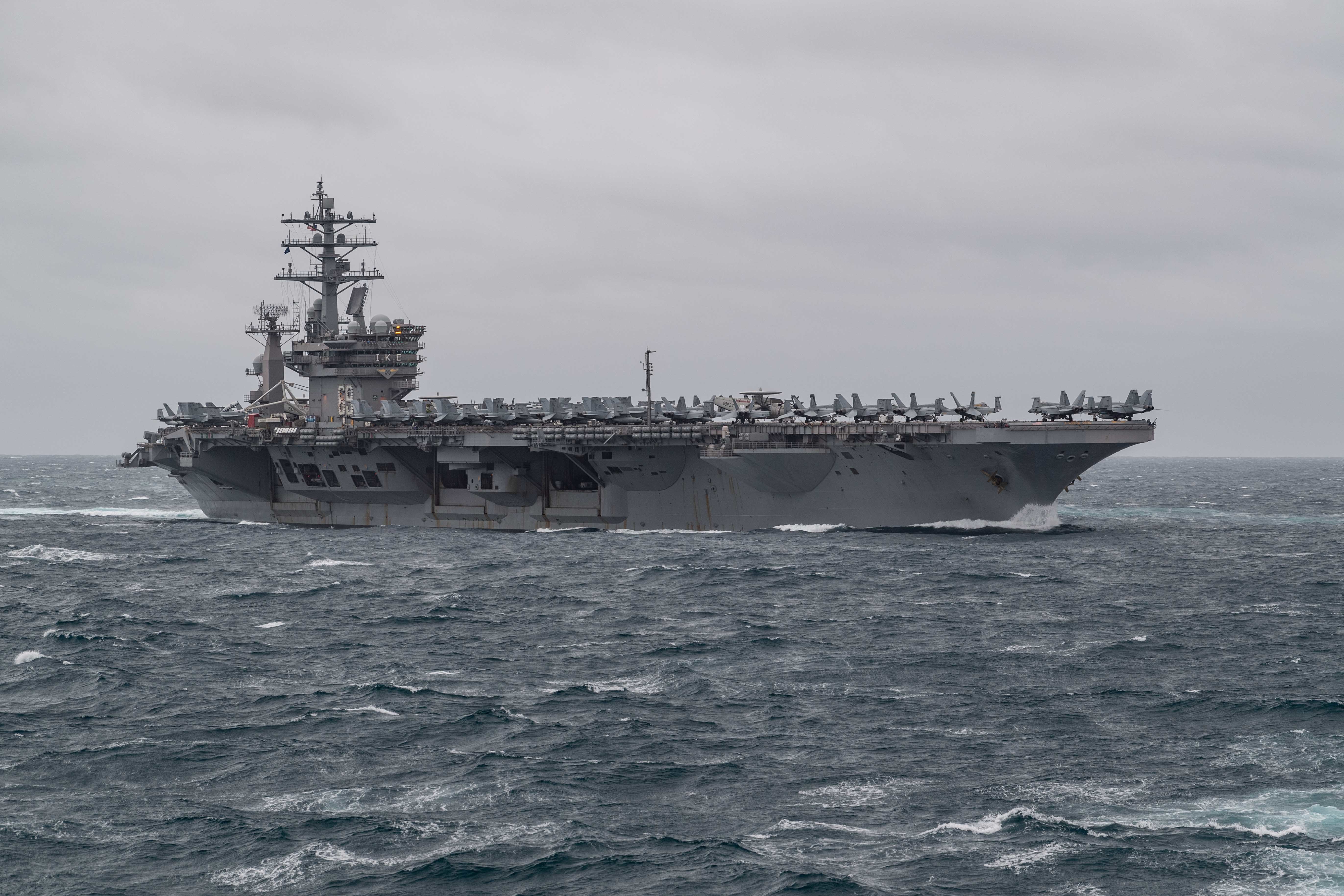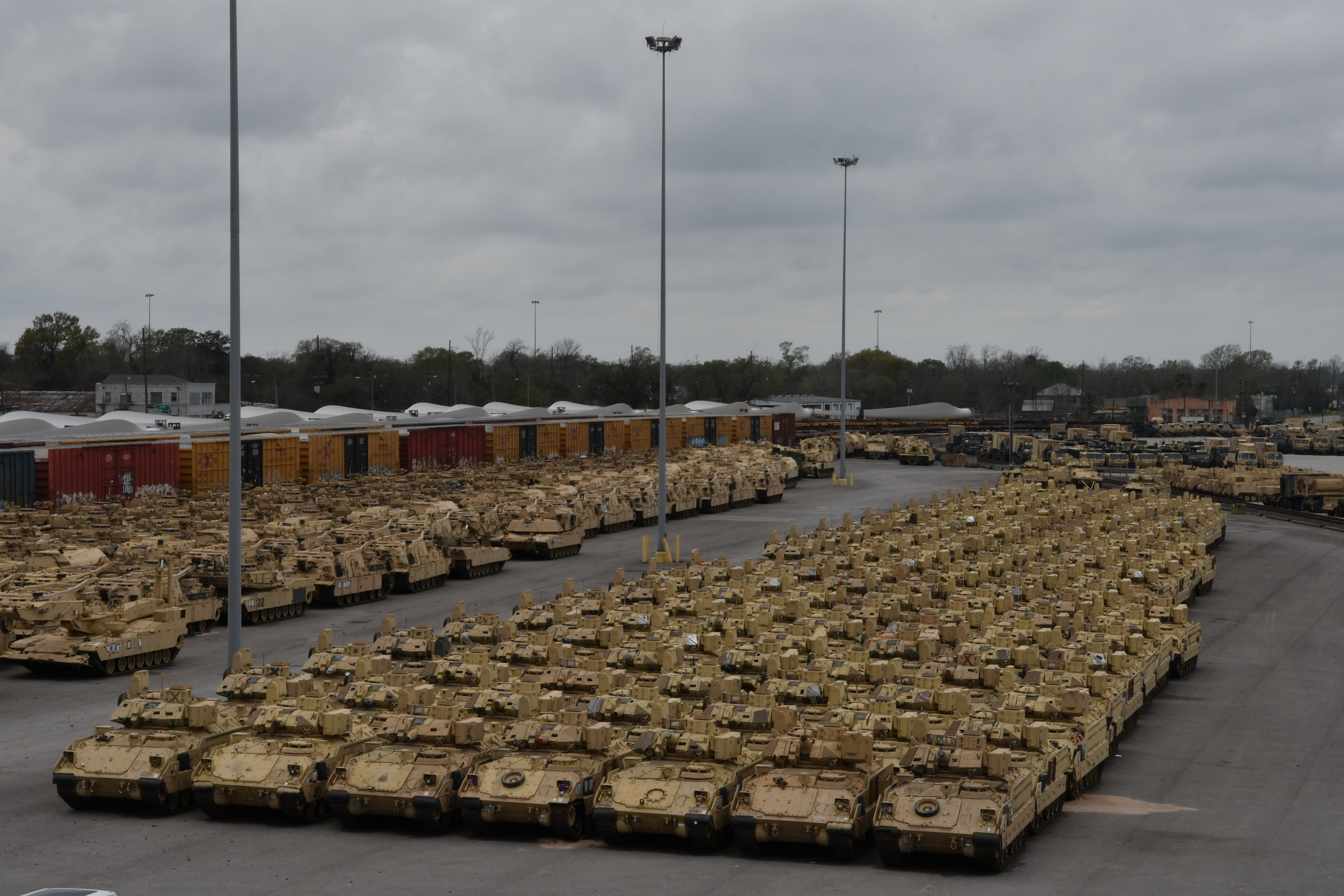
USS Dwight D. Eisenhower transits the Atlantic Ocean earlier this month.
PENTAGON: Since its surprise deployment last week, the USS Eisenhower has been clearing a path for cargo ships full of Army equipment bound for major ground exercise in Europe, the first drill simulating a contested crossing of the Atlantic since 1986, Navy officials say.
The Ike, along with an unidentified submarine sweeping the depths of the ocean for unexpected Russian guests, is participating in an exercise that will throw simulated attacks at the convoy to stress test how prepared the Navy is to punch its way across the Atlantic. The path is being cleared for the roll-on/roll-off USNS Benavidez, along with US-flagged merchant vessels MV Resolve and MV Patriot, which departed Beaumont, Texas Feb. 24 to deliver equipment to the US Army DEFENDER 20 exercise in Europe. The ships are carrying gear for the 1st Armored Division, including Abrams tanks, Bradley Fighting Vehicles, and other heavy armor.

Vehicles await to be loaded on commercial ships in support of DEFENDER-Europe 20 in Beaumont, Tx.
DEFENDER, which involves sending 20,000 US soldiers and their equipment to Europe for months of exercises with NATO allies, is the largest land exercise on the continent in 25 years. It will cost the Army about $340 million.
“The Atlantic has changed dramatically over the last 20 years,” 2nd Fleet’s director of operations, Cmdr. Troy Denison told reporters Friday. “It’s not what it used to be. We treat it as contested waters now.”
The changes in the Atlantic are a refrain Navy leaders have echoed for the past two years, given increased Russian submarine activity in the North Atlantic.
In October, Cold War-style gamesmanship was at its height after the powerful Russian Northern Fleet pushed 10 submarines into the North Atlantic where they conducted a series of live fire tests, all while playing a game of cat-and-mouse with US and NATO subs and sub-hunting aircraft.
In response, three US B-52 bombers flew along the Norwegian coast accompanied by several Norwegian F-16s in a show of force, followed by photos of the USS Minnesota fast attack submarine taking on MK-48 torpedos at Haakonsvern Naval Base on Norway’s west coast.
Days later, the 6th Fleet promoted a port visit by the guided-missile destroyer USS Gridley in Tromso, Norway before it participated in a multinational exercise nearby.
In the coming days however, the simulated attacks on the Ike and its merchant marine followers will run the gamut from electronic attacks to air and submarine strikes, Navy officials said.
Capt. Hans Lynch, commodore of Military Sealift Command Atlantic, said a complicating factor for the exercise is communications. Civilian ships rely on commercial services for communication, and use Iridium satellite phones and commercial antenna. “It can be very challenging for us to communicate with ships that are even right next to us,” he said.
Sealift Command is focused on improving its command and control, Lynch said, a critical gap as the merchant ships share virtually no communication technology with the Navy ships they sail with.
It’s not clear how or when those gaps will be filled, given the Navy’s budget reductions in the 2021 request and the flat budgets expected in the years to come.
Navy officials say the cargo ships will head to ports in Europe to unload their hauls in the coming weeks, but won’t comment on where the Ike heads next. The carrier deployed without returning to port after a series of exercises to prepare for deployment earlier this month, something the Navy says keep potential adversaries on their toes.
Other ships in the strike group include the cruisers USS San Jacinto and USS Vella Gulf, along with destroyers USS Stout, USS James E. Williams and USS Truxton.
The carrier strike group could participate in DEFENDER in a more direct fashion in coming weeks, or peel off to the north to take part in the Cold Response exercise in Norway. American participation in Cold Response was initially slated to be 7,500 troops, but that has been whittled down to abort 1,500 given events in the Middle East. There were preliminary plans for a carrier strike group to participate, but those were put on hold, while an Amphibious Ready Group full of Marines was diverted from Cold Response to the expanding mission to deter Iran.
“The Atlantic is a battlespace that cannot be ignored,” said Vice Adm. Andrew Lewis, 2nd Fleet commander said in a statement. “We need to be prepared to operate at the high end alongside our allies, partners and adversaries alike as soon as we’re underway.”
The aging US merchant fleet has been a cause of concern in recent months, with the Navy squeezed for funding to replace ships that are nearing the end of their lifespans. In September, Transportation Command ran a snap drill to find out how many of the nation’s Ready Reserve Force ships could set sail on short notice.
Overall, 33 of the government’s 66 ships were activated, and of those, only 22 were ready enough to leave port, according to a December Transcom report.
Northrop sees F-16 IVEWS, IBCS as ‘multibillion dollar’ international sales drivers
In addition, CEO Kathy Warden says the company sees a chance to sell up to five Triton UAVs to the NATO alliance.



























